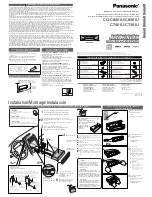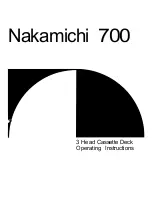
10
Special Design Features
Congratulations on your purchase of the Nº37 CD Transport. The Madrigal design
team is confident you will enjoy the outstanding performance of the Nº37 for
many years. In case you are interested in technical details, what follows is a brief
outline of some of the key technologies in your new transport.
A New Generation
The characteristics of an outstanding CD transport are simple to define: it must
recover the correct data from the disc, and deliver it to the digital processor with-
out any timing errors (sometimes called “jitter”). As simple as this sounds, achiev-
ing it in reality has been extremely difficult—as evidenced by the significant
sonic differences between various CD transports.
Conventional CD transport design depends on the quality of the oscillator used
to control the rate at which the disc itself spins. This oscillator exists in an ex-
tremely “noisy” electrical environment close to the motor that spins the disc. The
electrical noise introduces timing errors in the delivery of the digital signal that
have come to be known as “jitter.” Subsequent handling of the digital audio sig-
nal in traditional transport designs cannot improve upon this “jittery” signal, lack-
ing a better reference. To the contrary, the various stages of signal processing be-
tween the laser pickup and the final output can only contribute additional jitter of
their own.
The Mark Levinson Nº37 leaps beyond conventional digital audio technology by
employing a proprietary, closed-loop jitter-reduction system in conjunction with a
double speed
CD
-
ROM
drive. Using a custom-made crystal oscillator with better
than five part-per-million accuracy, the digital signal is reclocked immediately be-
fore the output, eliminating transport-related jitter from the digital audio signal.
This same crystal oscillator controls the all-digital servo used to control the rate
at which the disc spins.
In effect, the design of the Nº37 turns the accepted
status quo
on its head. By
placing the all-important reference clock in the
final
stage of the transport’s out-
put section, and slaving the mechanical subassemblies to it rather than the other
way around, the signal presented to the outputs of the Nº37 is uncontaminated
by electrically- or mechanically-induced jitter. The sonic advantages of this design
are immediately apparent in the clarity, warmth and stunning dynamic contrasts
exhibited by the Nº37.
Digital Servo Control
The laser mechanism used in the Nº37 uses all digital servo controls of its opera-
tions. Critical functions such as focus and tracking are handled completely in the
digital domain with mathematical precision. Whereas conventional, analog servos
require periodic realignments for optimum performance (to compensate for the
aging of various analog components), a digital servo remains stable over time,
never needing readjustment under normal conditions.
Output Versatility
All high quality digital output configurations are supported in the Nº37. A new
complementary driver for the balanced AES/EBU electrical output delivers out-
standing performance to the high quality XLR connector. Single-ended S/PDIF
electrical outputs are provided
via
both BNC and RCA connectors, and the ST











































